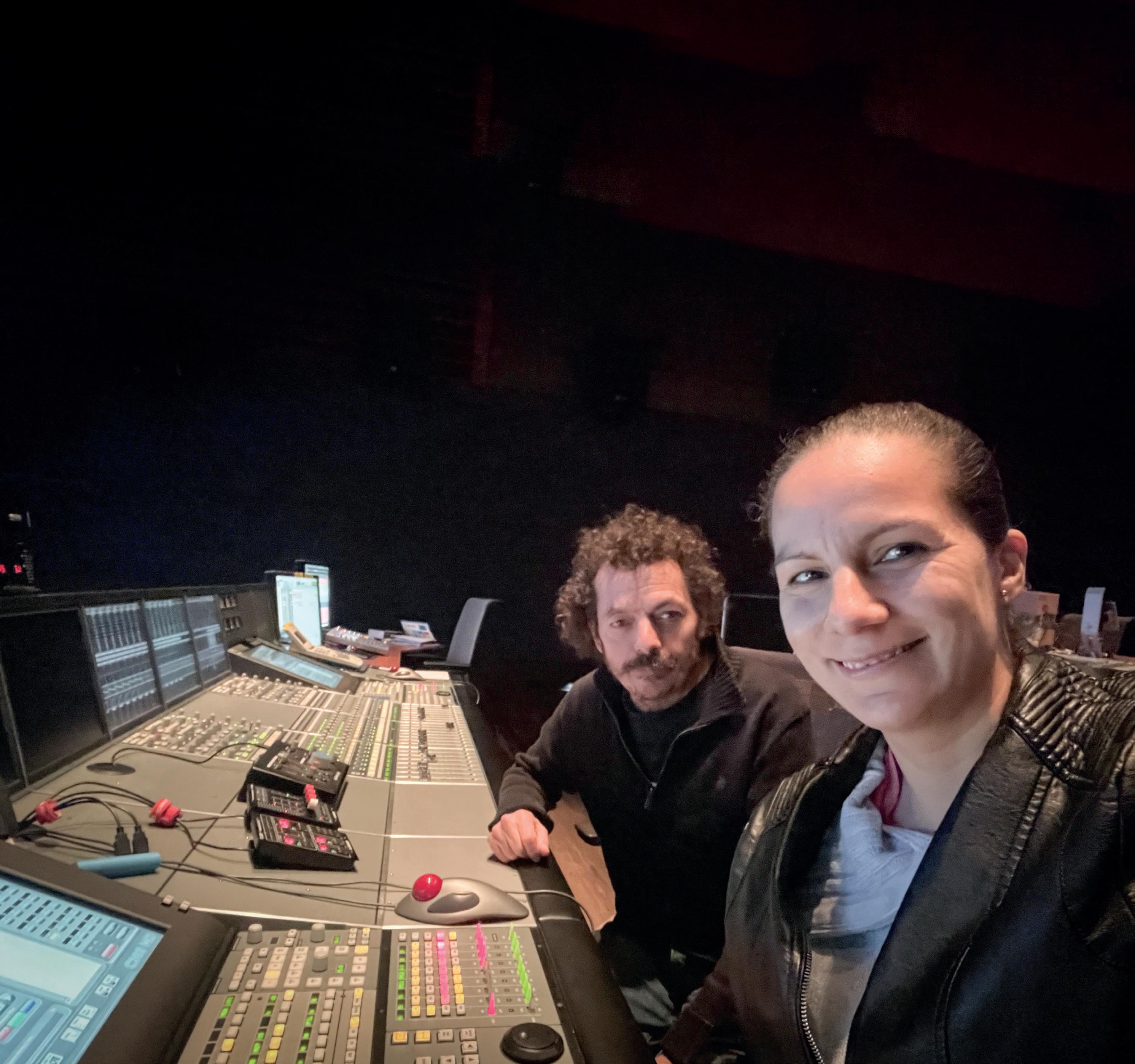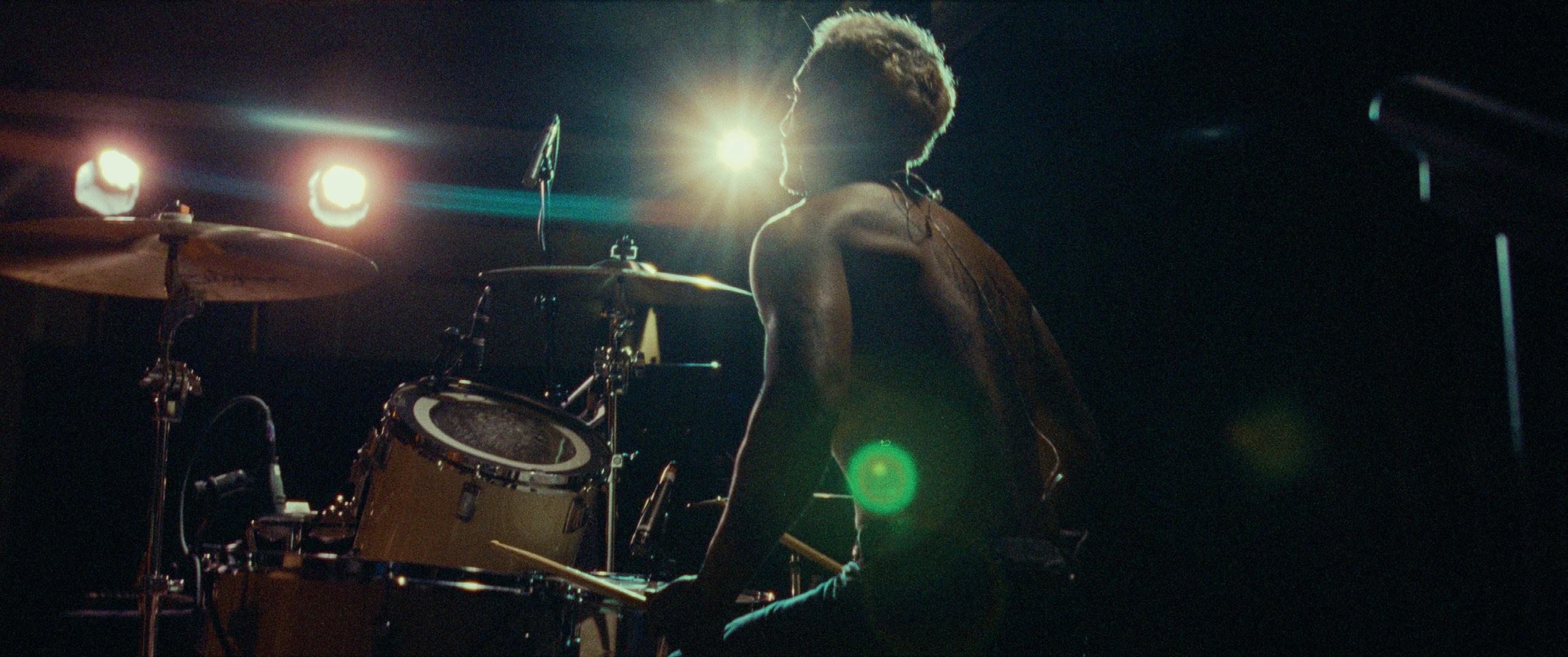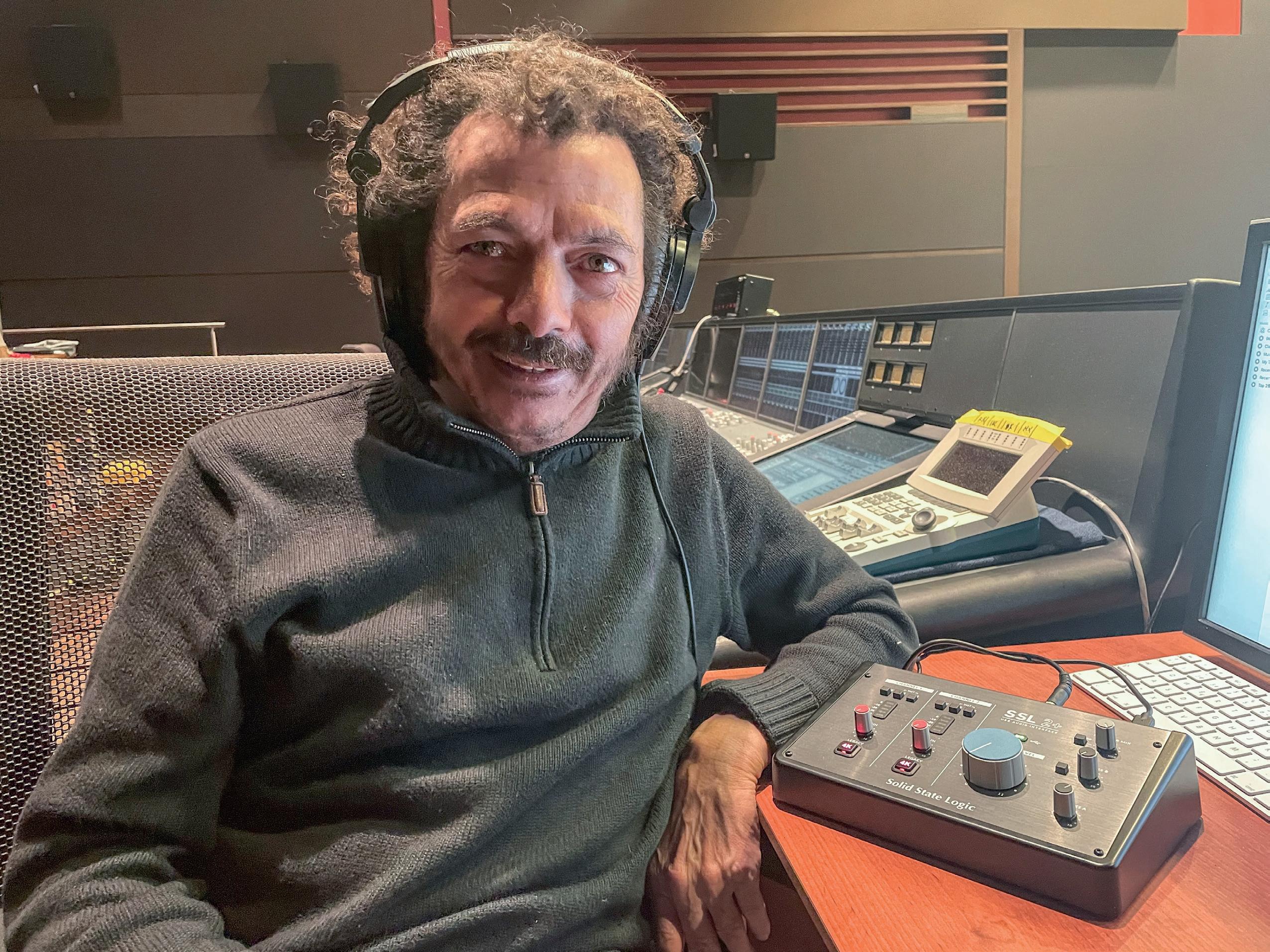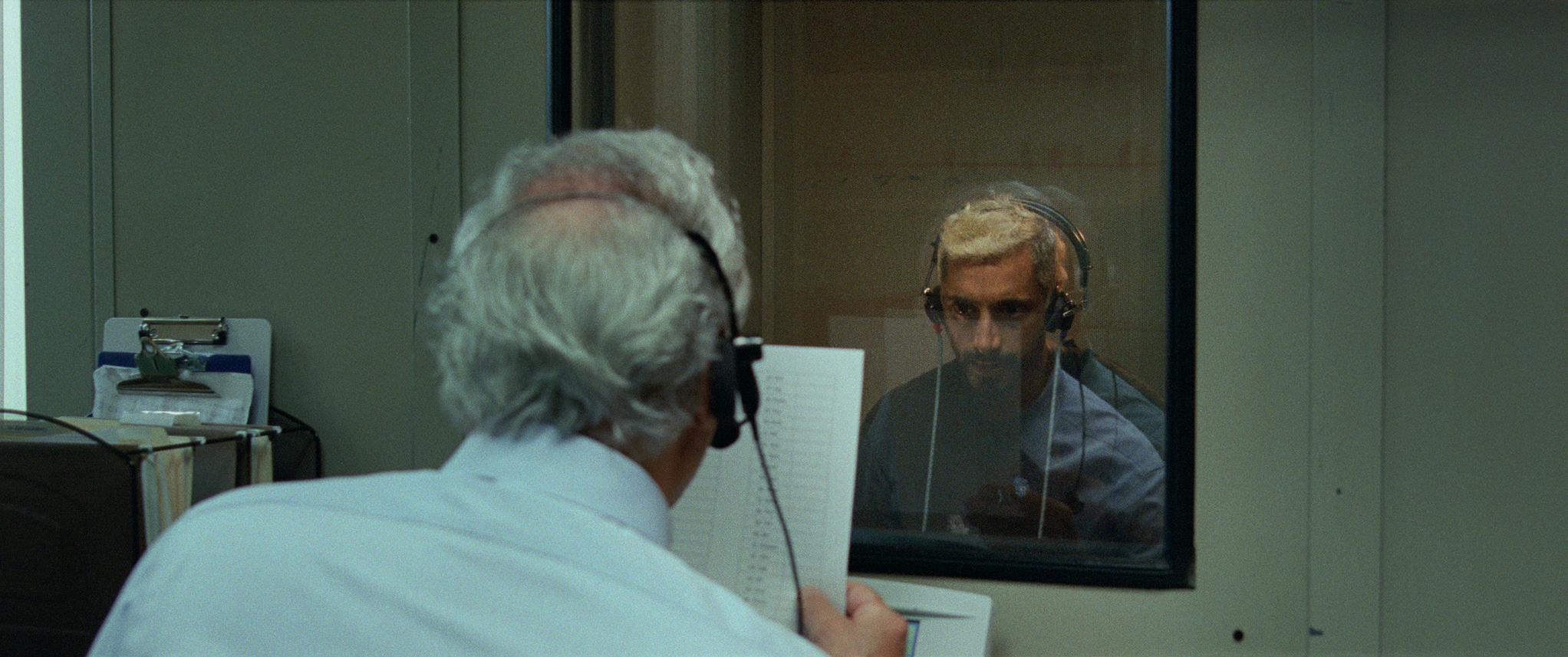
15 minute read
Michelle Couttolenc and Jaime Baksht
Jaime Baksht and Michelle Couttolenc
The recent Oscar-winners for Sound of Metal chat with JOHN MOORE about their work on Darius Marder’s breakthrough indie hit, and creating its uniquely disturbing soundscape
/ Michelle Couttolenc and Jaime Baksht at their SSL C300 desk at Astro LX, with there favoured TC Electronics reverb and delays ready to go
Having worked together for nigh-on 15 years, Jaime Baksht and Michelle Coutollenc first appear on a credits list together for 2006’s Mexican drama La última mirada — also Couttolenc’s first credit on
IMDB. During the same year, they worked together on Guillermo Del Toro’s cult classic Pan’s Labyrinth, with Baksht as re-recording/ dubbing mixer and she as assistant. While
Michelle leaned towards sound recording and
ADR as well as mixing in her early career, latterly they have operated side-by-side on an impressive number of productions — forging an enviable reputation for their work in the process.
Recently, their stars have truly shone as part of the team responsible for the striking, Sound of Metal, director Darius Marder’s self-penned tale of a musician that loses his hearing, and the effect that has on all aspects of his life, most markedly his relationships and self-image. It’s that rarest of beasts in the highly visual world of the movies: a project that leans as much on its sonic qualities as its visual — and one that has rightly been heaped with praise for its impactful sound design.
The film was mixed by the duo — along with Carlos Cortés — from raw materials provided by supervising sound editor Nicolas Becker, production sound mixer Phillip Bladh, and foley artist Heikki Kossi during the before-times of 2019. Though subsequent events have seen it largely distributed via streaming platforms, rather than through theatres — especially in Europe — that hasn’t lessened the impact of their collective work, or the impression it has left with viewers.
While Baksht and Couttelenc are currently most closely associated with Mexico City’s Astro LX facility, Sound of Metal was largely mixed to the south of the country’s metropolis at Cortés’ base, Splendor Omnia near Tepoztlán. Though, as we will find out, the pair couldn’t resist a quick trip back home to polish their work using their own, trusted equipment.
Resolution spoke to them via Zoom from LA as they prepared for their big night at the Oscars… One that would turn out very well for them.
At what point did you first hear about Sound of Metal? Who introduced you to it and how?
Michelle Couttelenc: The first contact was because Nicolas Becker was when he was doing work with Mexican musicians in New York City, and there there was another musician Leonardo Heiblum [half of composing/ production team, Audioflot] who is Mexican and who he wanted to collaborate on this project.

Nicholas was telling him about the film, and that he needed a place and the people to mix the film. Because it was a non-conventional film in [terms of] sound, they didn't want to mix it in LA, they wanted to do a different approach. And that was when Leonardo said to Nicolas: ‘Well, you should go to Carlos Reygadas' studio, Speldor Omnia, in Mexico — and then call Jaime and Michelle to do the mix.’
That's when Nicolas called Jaime to ask if he wanted to be part of the project.
How was Sound of Metal pitched to you? Was there already a very solid idea of how it was going to sound?
Jaime Baksht: Well, the thing is, Darius Marder and Nicholas Becker, who is a sound artist in France, had been working on the project for a year before they even shot it. They were researching what is like to lose your hearing, so they interviewed a lot of people with hearing problems, and they also talked with a lot of doctors.
I think what happened is that Nicolas suggested taking the main character of the film, Riz Ahmed [who plays Ruben], into an anechoic chamber at IRCAM in France — and they started to record the internal sounds of his body. So they were able to record the blood moving around his body, and obviously the heartbeat — which is something that is easier. But, it turns out if you get into a really quiet place, our bodies are really, really noisey. We are really noisy!
Nicolas used a lot of different type of microphones — contact microphones, stethoscopes — they also took recordings inside a swimming pool. The backgrounds in the film, ambience and all that stuff, were recorded while already thinking about that ‘muffled sound’ idea. So we really didn't use a lot of filtering, we just combined a lot of different textures. MC: There were a lot of different textures: low, medium, and high [frequency], and some different things. IRCAM provided software made especially for Nicholas and for the film, where if you put in dialogue or sound you could adjust the level of distortion and separate different transients. So Nikolas gave us the different textures and things he wanted to use, and then in the mix, we combined all the textures and gave them the levels, the movements and all the things that happened.

/ The pair were given creative freedom to manipulate the sound of Ruben’s cochlear implants, based on treated audio supplied by sound designer Nicolas Becker
So were you interpreting what you thought was necessary by essentially playing the faders of the different elements? Were you automating in Pro Tools?
JB: Nicolas and Darius, did a proposal for how things are supposed to sound to Ruben using Pro Tools. With some labels and some ideas... But the thing is, we had a theory about [how to approach] the mix, which was, for me, really important: Ruben wasn't born that way and doesn't lose his hearing until he is in his 30s. So that means he has a lot of 'sound memories', he remembers how the sound of things used to be. So using that idea, we tried to use the examples that Nicolas and Darius gave us, but we said, 'well, it is going to be quite boring if the whole movie is muffled... We need to use the idea that he was able to hear. So let's try to make it that, when you're not really 'inside' the character. Let's try to use normal sounds.
From the way the sound in the film's set up, dynamically, when you realise Ruben's hearing is gone, you don't miss the loudness of the concert, you miss the quieter sounds when they disappear, don’t you?
JB: Well, in the case of the main concert, we wanted to make it as loud as possible… To the limit... We took it to the limit. How many how many times did we remix that concept? MC: I think we we remixed it 10 times! Darius was already happy. I don't know which version it was, but he told us 'I think it sounds pretty good right now’, but Jaime and myself, we're like, 'No, no, no, we should remix it again' because it needs to
/ Jaime utilised the SSL 2+ interface to listen back to stereo delivery mixes for Sound of Metal’s streaming release, which he and Michelle oversaw

be loud. It’s the first opportunity to be inside’ the character and you need to feel it really, really close to you, and be really inside him. So we did a lot of approaches... And then there is the progression of his hearing loss and the combination of all these elements.
There’s a hint at even in all that loudness at the start that his hearing is leaving him, right?
JB: At the beginning, we thought that making a wall of sound would be more effective. The first scene is really, dynamically speaking, the biggest moment. And then as the concert finishes, we go to the trailer, parked, and there is almost nothing. So we wanted to have these kind of really heavy difference in the dynamics in the film sound, but at the same time, we start to wash out the sounds inside the concert.
We start really bright, but then we focus on the instruments — we go to the drum. When the shot goes to the drums, we don't want to have a nice balance between the instruments, we want more of what the camera is looking to. So yeah, if you're talking about that, yeah, that was one of the decisions. Everything sounded beautiful — loud, but beautiful — but then Michelle and I realised that with each cut, and where the camera was, we needed to make it more realistic. MC: When you have a close-up of the drum, you get that little more of the drum — and if you had the sticks they were a little bit louder, or if he was on the cymbals… JB: We did so many versions. Version one was a really nice balance of the concert. In the second version, we had this idea that Michelle is talking about. The third one onwards, we pushed the boundaries even further… to where the balance was completely out, and it doesn't matter. By the 12th one, we have what is in the movie!
When you’re hearing what Ruben is hearing, especially towards the end of the film, how much did you play with the ‘reality’ of what he's hearing? How much freedom were you given with the material?
JB: We have all the natural sounds, we have all the muffled sounds, even the music — which doesn't have melody, and is more like ambient music, so it's only textures, more like into a tone. So we use the music in moments where Ruben’s muffled soundscape and these tones combine for an emotional moment. MC: When Ruben gets the implant, when he has it connected. The first approach that Nicolas, Darius and Carlos made was that — because doesn’t have both ears connected, the directionality of the sound is obscured, he doesn't really know where the sound is coming from.
So there’s a mix with omnidirectional sound, that's coming around him, and everything is everywhere. Then we proposed a different approach in which, yes, it has no directionality — but we felt it needed to be more disconcerting and more like he's being bombarded by sounds from everywhere. So we created ‘bubbles’, that were sound from around him but moving around as if in a bubble. Then there’s another bubble of sounds elsewhere, also moving. Then there’s one other bubble that contains both of the others, and that makes everything move around him. So we had this freedom of proposing different things to make it more disconcerting and immersive where you’re with the character. JB: It was a lot of freedom. Darius and Nicolas worked together first, and they gave us the pallet of sounds. They crafted their own version of the idea, and then they said to us, ‘okay, that's the sound of the movie, what you can do with this?’
You used Cargo Cult’s Spanner for those bubbles, I understand? I assume, by the time the ‘Paris’ scenes come, which are a complete cacophony at points, you could pretty much add in anything you wanted?
JB: For that last scene, there were three instances of Spanner one after the other, that's what Michelle is talking about with the ‘bubbles’. One bubble, in 5.1 over the head of the character for each cut. Then all the ambience was another Spanner, again in 5.1 but with different perspective. And then there was the last one, with all the other spanners inside. And this one was a chaotic one.

Did Sound of Metal instantly feel like an opportunity, a massive chance that you were not going to get very often?
MC: It's not very often that sound is so important. Even if there are a lot of directors who think about sound, it's very special here... it's the principal. The main character of the movie is the sound, so that is what's really crazy. And also there [was Darius telling us] ‘do you want to try this’ and [saying] ‘be creative… do whatever you think would be the best for the film!’
So, yes, it was a really great opportunity to develop and to try new things and it's really an honour to work on a film where the director comes to the sound designers and says ‘the sound is the main thing we want to do and you should develop it’.
And I remember Darius asking us ‘how many movies where the main title includes the word sound have you worked on?’
We know it’s not many!
You've worked together for a long time. How do you use your roles to complement each other, and how do you like to work during sessions?
JB: The current thing is the technology is changing. So it seems like in one box you can do everything. I don't really agree with that.
I'm an old man, and I understand that Pro Tools can do a lot of things, and everybody believes that it’s faster. I don't think so. Because the problem with in the box is that it doesn't sound big. It takes a long process to make a big sound. So, I prefer large format consoles.
Right now in the main studio where we are working, Astro LX, we have a big SSL console. If I don't have the SSL, I'm going to cry. We mixed Sound of Metal on the AVID S6, which is good… but it doesn’t really have a sound, it’s like an empty glass of wine, when perhaps you’d prefer a pint of bitter! SSLs also have amazing automation systems and everything is one button to do a lot of things. So you really are into the sound and less into the button pressing. So my SSL is my SSL. We also have a Fairlight, which we love.
Michelle is really good in Pro Tools, she knows all the tricks, you know... I am the guy with one finger on the keyboard… you know, not very fast. But I have my ideas and so I do some editing, and some Pro Tools — and if she has an idea of how to mix some of the moments of a film, she’ll do it. I don't have any problem with this.
Then we listen to the scene, if we have any comments we say our comments. Sometimes Michelle says: ‘okay, that is your view, do your corrections’. So we combine. There is no ‘she does dialogue and I do FX and music’, it is like we do anything we think we need to do.
Something we’ve developed, Michelle and I, is knowing when we need to edit, and when we are going to mix. That's the first thing we clarifed in 14 years of work. You don’t want to be editing during the mix, and you shouldn’t be trying to mix during editing — both of which are quite common. So we'll define perfectly clearly when we need to do each. MC: Sometimes we do separate, but with Sound of Metal, we used more of a combination because more ideas are better. It's best for the movie to have more minds thinking about the best way to do it.
Most of the film was mixed at Splendor using S6, as Jaime says, but then we took all the stems to Astro LX and the SSL C300, we listened to those stems and realised we needed to do adjustments. So we had the Pro Tools stems coming into the console and getting the SSL sound and flavour, then we recorded it to the Fairlight — that also has an amazing quality. When we work at Astro LX we always operate like this: our main stems, and final stem masters recorded on to the Fairlight.
Of course, there are plugins that we love, like Spanner or iZotope — and there were other plugins that Nicolas used. It’s the combination of plugins and the real gear that made the difference, and also helped us take care of the details — because we’re not just doing it automatically. We love our SSL and the Fairlight, and also there will be some TC Electronic plugins with hardware controllers — like the TC2290 delay and the DVR250 reverb plugins — that we also used.
/ Ruben’s internal soundscape was realised with a series of unusual foley and ADR recordings, including some made underwater
Obviously, in the UK the movie has largely been seen on streaming platforms, given the last year... How much emphasis do you generally put on downmixing for streaming platforms? What's your work process for doing that?
MC: Here, it was an opportunity, because sometimes the delivery is just an automatic downmix. In this case, it was not at all, it was Jaime and myself doing the mix. With the delivery stems for Amazon and broadcast, they we're done at Astro LX with the SSL and with the Fairlight. So it's like a real, ‘real’ sound. Not 'in the box' sound. JB: Of course, we mixed it in 5.1 for the theatrical format, in that format we have the biggest potential soundfield. There was no pandemic in 2019 when we mixed Sound of Metal, so we mixed for the theatre. When it came to the delivery formats, Michelle and myself decided to do it... We normally don't do deliveries, but this time we said ‘no, we want to do the stereo version and we want to do the 5.1 TV version’. MC: We took a lot of care of the stereo version — and the TV 5.1 — to get them as close as possible to the theatrical version’s impact, to capture the moments that we knew were there in the theatre version. To translate all these moments to the stereo version, so it could be as good.







